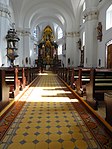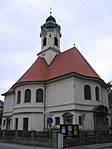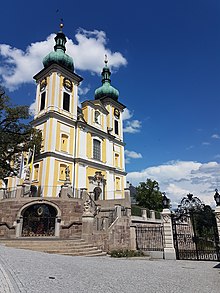Donaueschingen
| coat of arms | Germany map | |
|---|---|---|

|
Coordinates: 47 ° 57 ' N , 8 ° 30' E |
|
| Basic data | ||
| State : | Baden-Württemberg | |
| Administrative region : | Freiburg | |
| County : | Schwarzwald-Baar district | |
| Height : | 686 m above sea level NHN | |
| Area : | 104.62 km 2 | |
| Residents: | 22,526 (Dec. 31, 2018) | |
| Population density : | 215 inhabitants per km 2 | |
| Postal code : | 78166 | |
| Area code : | 0771 | |
| License plate : | VS | |
| Community key : | 08 3 26 012 | |
| LOCODE : | DE DEN | |
| City structure: | Core city and 7 districts | |
City administration address : |
Rathausplatz 1 78166 Donaueschingen |
|
| Website : | ||
| Lord Mayor : | Erik Pauly ( CDU ) | |
| Location of the city of Donaueschingen in the Schwarzwald-Baar district | ||
Donaueschingen is a city in the southwest of Baden-Württemberg , about 13 km south of the district town of Villingen-Schwenningen . The middle center is the second largest city in the Schwarzwald-Baar district .
Until the district reform on January 1, 1973, Donaueschingen was the district town of the Donaueschingen district and has since been part of the Schwarzwald-Baar district. Donaueschingen has been a major district town since July 1, 1993 .
In addition to Villingen-Schwenningen , the next larger cities are Tuttlingen about 24 km east, Singen (Hohentwiel) about 34 km southeast and Schaffhausen , located in Switzerland , about 30 km south of Donaueschingen.
geography
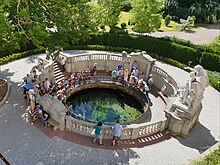
Geographical location
The city is located on the high plateau of the Baar , between the eastern edge of the southern Black Forest and the western Swabian Alb in the valley of the Brigach , whose confluence with the Breg near Donaueschingen is considered to be the actual beginning of the Danube . A contained karst spring in the castle park, the Donaubachquelle, is also known as the " Danube spring ". The district is the only municipality that extends continuously from the granite and gneiss of the Black Forest over the Triassic formations of the Black Forest eastern roof and the Baar to the Jura of the Swabian Alb and can include all the rock layers of the southern German plain. The heights drop from 1020 m in the Black Forest to about 660 m on the Baar, only to exceed the 900 m mark again on the Swabian Alb. A model shows the extraordinary geological situation of the city and its surroundings in the park opposite the train station.
climate
| Donaueschingen 2015–2020 | ||||||||||||||||||||||||||||||||||||||||||||||||
|---|---|---|---|---|---|---|---|---|---|---|---|---|---|---|---|---|---|---|---|---|---|---|---|---|---|---|---|---|---|---|---|---|---|---|---|---|---|---|---|---|---|---|---|---|---|---|---|---|
| Climate diagram | ||||||||||||||||||||||||||||||||||||||||||||||||
| ||||||||||||||||||||||||||||||||||||||||||||||||
|
Average monthly temperatures and precipitation for Donaueschingen 2015–2020
Source: [2]
|
||||||||||||||||||||||||||||||||||||||||||||||||||||||||||||||||||||||||||||||||||||||||||||||||||||||||||||||||||||||||
Neighboring communities
The following cities and municipalities border the city of Donaueschingen. They are named in a clockwise direction starting in the northwest:
Vöhrenbach , Villingen-Schwenningen , Brigachtal , Bad Dürrheim (all in the Black Forest-Baar district), Geisingen ( Tuttlingen district ) and Hüfingen and Bräunlingen (all in the Black Forest-Baar district).
City structure
The urban area consists of the city center , the towns of Allmendshofen and Aufen, which were incorporated in the 1930s, and the communities of Aasen, Grüningen, Heidenhofen , Hubertshofen, Neudingen , Pfohren and Wolterdingen , which were incorporated as part of the community reform of the 1970s .
The most recently annexed parts of the city are also villages within the meaning of § 67ff of the Municipal Code , that is, they each have one of the eligible voters in each municipal election to be elected directly Ortschaftsrat , with a mayor as chairman. The number of local councils is between six and ten, depending on the number of inhabitants.
Some parts of the city have more spatially separate residential areas with their own names, which often have very few residents, or residential areas with their own name, whose names have emerged in the course of development and whose boundaries are then usually not precisely defined. In detail, these are the following areas:
- to the core city: Dürrheimer Landstrasse, Fohrenhöfe and In den Tannenäckern, Jägerhaus as well as Bruch- und Schluchsiedlung and Neue Heimat
- to Neudingen: On Teil, Gnadental and Mariahof
- zu Pfohren: Immenhöfe
- to Wolterdingen: Hintere Schand, Lettenäcker and Zindelstein
Spatial planning
Donaueschingen forms a middle center within the Black Forest-Baar-Heuberg region , in which Villingen-Schwenningen is designated as a regional center. In addition to the city of Donaueschingen, the cities of Blumberg , Bräunlingen and Hüfingen belong to the central area of Donaueschingen .
history



Donaueschingen was first mentioned in a document in 889 as Esginga . During the time of the tribal duchies , Donaueschingen was part of the Duchy of Swabia . From 1101 to the 13th century the place belonged to a local noble family who were presumably servants of the Reichenau monastery . By the end of the 13th century at the latest, it was the Lords of Blumberg who ruled the place until the middle of the 15th century, then knight Sigmund vom Stein followed until 1465.
In 1283 Rudolf von Habsburg enfeoffed Count Heinrich von Fürstenberg with the counties of Baar and Donaueschingen. This also included the right to brew beer. This is where the Fürstlich Fürstenbergische Brewery originated.
In 1488, Donaueschingen was bought into the possession of the Counts of Fürstenberg . From 1500 the place was in the Swabian Empire . In 1653 Ferdinand Friedrich von Fürstenberg chose Donaueschingen as his residence. Since 1716 the place has been the headquarters of the Prince of Fürstenberg. In 1801 Donaueschingen became the seat of an upper bailiff of the Fürstenberg rule. In 1806 the place came together with the principality to the Grand Duchy of Baden and one year later it became the seat of an office, which was dissolved again in 1810. In return, Donaueschingen was granted city rights on January 27, 1810. In 1813 the Donaueschingen office was re-established, dissolved again in 1818 and re-established for the second time in 1849 and later elevated to a district office. In 1908 a large part of the city fell victim to a fire. Donaueschingen, which had 8,901 inhabitants in 1939, was 13% destroyed by air raids during World War II. The Donaueschingen district emerged from the Donaueschingen district office in 1939 and was dissolved during the district reform in 1973 . Most of his communities and with him the district town of Donaueschingen were assigned to the newly formed Schwarzwald-Baar district. As a result of the incorporation of seven neighboring communities in the 1970s, Donaueschingen developed into the second largest city in the district; In 1992 the population exceeded the 20,000 mark. As a result, the city administration applied for a major district town , which the state government of Baden-Württemberg then decided with effect from July 1, 1993.
The districts of Donaueschingen also have a long history. They mostly belonged to the Principality of Fürstenberg and came to Baden in 1806. First to the higher office in Hüfingen , in 1813 to the office of Donaueschingen, in 1819 to the office of Hüfingen and again from 1849 to the office of Donaueschingen, later to the district office of Donaueschingen, from which the Donaueschingen district emerged in 1939. However, Grüningen only came to the Donaueschingen district office in 1936.
- Aasen was first mentioned in 973 as Usin . A local nobility is mentioned from 1094, the castle stables of Aasen Castle have been preserved.
- Allmendshofen was first mentioned in 870 as Aleuuigeshouun . A local nobility is also mentioned here, but nothing of their castle has survived. The place came to Fürstenberg through the dominion of Blumberg and von Schellenberg.
- Aufen was first mentioned in 889 as Uffheim . It is probably a development place of Donaueschingen, which was divided into Unteraufen (later Niederaufen), Suntheim and Oberaufen in the 14th century. 1488 came the place with Donaueschingen to the Lords of Fürstenberg.
- Grüningen was first mentioned in 1109 as Gröningen . Other sources report that Grüningen was first mentioned in 805 in a document from the St. Gallen monastery in what is now Switzerland. In the 13th century there was a local nobility, but the place then came to Fürstenberg and with the sale of Villingen in 1326 to Austria ( Upper Austria ). In 1805 Grüningen came to Württemberg and in 1806 it was given to Baden in exchange. The place then belonged to the Obervogteiamt or district office Villingen and only came to the district office / district of Donaueschingen in 1936. Count Gebhard zu Fürstenberg, Canon of Constance and Parish Rector for Grüningen was the biological brother of Count Egon zu Fürstenberg. The wall frescoes in the Mauritius Church in Grüningen from the 13th and 14th centuries, which can still be viewed today, are attributed to this noble clergyman. Traces of the Spanish War of Succession are also visible in Grüningen. Two relics from this period remind us of this, once the cannon balls on the choir arch in the church and the Spanish cross , which shows the murder of a nobleman from the royal family and is in the Ochsenberg district.
- Heidenhofen wasfirst mentionedin 759/60 as Heidinhova . The St. Gallen monastery had possessions. In the 10th century, the place came to the monastery Reichenau . In 1447 Heidenhofen was sold to the Fürstenberg rule.
- Hubertshofen was first mentioned in 1440 as Humbrachtzhoven . Unlike the other parts of the city, Hubertshofen belonged to the neighboring community of Bräunlingen and shared the fortunes of this city. The place remained Austrian until 1805. The Fürstenbergers recognized the sovereignty over the place no later than 1686. In 1805 to Württemberg Hubertshofen came to Baden in 1806 and was then assigned to the Villingen office, from 1813 to the Hüfingen office, 1832 to the staff office and in 1840 to the Villingen office, then in 1849 to the Donaueschingen office.
-
Neudingen wasfirst mentionedin 870 as a niginga . The place was probably the center of a royal estate in the Baar. In 949 the place was given away to the Reichenau monastery. From 1108 a noble family is mentioned, but the place came to Fürstenberg at the beginning of the 13th century. Fürstenberg Castle was built from here. A deep castle was sold to the Mariahof monastery in 1503. The hamlet of Mariahof, which belongs to Neudingen, was first mentioned in 1274 as "Capella dicta super Curiam". A monastery was founded in the 13th century. The monastery church was separated from the Neudingen parish church in 1274. Then the monastery was settled by beguines from Neudingen. The nunnery was under the Dominicans from Rottweil . In 1337 the monastery was chosen as the burial place of the Fürstenbergs. During the Reformation the monastery was abandoned, but settled again in 1562 and 1584 andincorporated into the Friedenweiler monastery. In 1802 it was secularized and in 1852 the church was destroyed by fire. The Fürstenbergers then built a crypt church there .
see also Neudingen Castle - Pfohren wasfirst mentionedin 817 as ad Forrun . Initially the monastery of St. Gallen had possessions, from 1086 a noble family is named. The place came to the Fürstenbergers in the 13th centuryvia the Zähringer .
- Wolterdingen was first mentioned in 772 as Wuldartingas . In the 10th century the place was given to the Reichenau. Around 1102 a local nobility is mentioned. Wolterdingen had come to the Fürstenbergers early on via the Wartenbergs. They gave the place to the Tusser von Lanzenhofen as a fief, but redeemed it again before 1450. The hamlet of Zindelstein belonging to Wolterdingen was first mentioned in 1225 as "Sindelstein". The small town came to the Fürstenbergers early on, but was then given several times to fiefs. In 1525 the place was destroyed in the Peasants' War. In 1533 the Fürstenbergers only acquired ruins. At that time, three Maierhöfe were also mentioned here. In the 17th century there was only one farm that was lost in the Thirty Years War. The goods were then awarded several times in the 17th century. This is where today's Ober- and Unterzindelstein emerged.
Incorporations
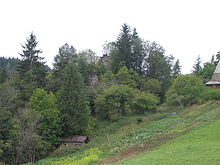
The following communities were incorporated into the city of Donaueschingen:
- 1933: Allmendshofen
- 1935: Aufen
- December 1, 1971: Wolterdingen
- January 1, 1972: Grüningen , Pfohren
- February 1, 1972: Aasen
- April 1, 1972: Heidenhofen
- July 1, 1972: Hubertshofen
- January 1, 1975: Neudingen
Population development
Population figures according to the respective area. The figures are census results (¹) or official updates from the respective statistical offices (main residences only).
|
|
¹ census result
Religions
Donaueschingen initially belonged to the diocese of Constance and was assigned to the archdeaconate “in front of the forest”. Since the sovereigns, the princes of Fürstenberg, did not introduce the Reformation , Donaueschingen and the surrounding area remained predominantly Catholic until the 19th century. The same goes for Grüningen, which, however, came to Upper Austria in 1326 and to Baden in 1805 via Württemberg in 1806. Since 1821 and 1827, the Catholic communities in what is now the city area belong to the Archdiocese of Freiburg and were initially assigned to the Villingen rural chapter. From 1933 Donaueschingen was the seat of a country chapter. The Donaueschingen dean's office was established in 1977. All of today's Catholic parishes in the city area belong to it. They have been united in a pastoral care unit since 2016. The pastoral care unit in Donaueschingen comprises the two parishes St. Johann (church from 1724/47 with subsidiary church St. Jakobus Allmendshofen, built 1721 (with older choir)) and St. Marien (church from 1927/28 with subsidiary church St. Vitus Aufen, built 1756 ), and the communities of St. Kilian Wolterdingen (church built in 1903 in neo-Gothic style), St. Mauritius Grüningen (church from the 14th century and tower from the 16th century), St. Sebastian Hubertshofen (church from the 17th / 18th century) Century with extension from 1885) (all three incorporated in 2015), St. Johannes d. T. Pfohren (church from 1767 rebuilt), St. Blasius Aasen (church from the year 1100, baroque extension in 1725/26), St. Hilarius Heidenhofen (church from the 15th century) and St. Andreas Neudingen (church from the late 18th century with St Anna's Chapel).
The St. Mary's Church in Donaueschingen was built under the pastor Heinrich Karl Joseph Feuerstein . Until his arrest in the Third Reich by the Gestapo in 1942 he was the parish priest of Donaueschingen. He was arrested because he spoke several times at Sunday sermons from the pulpit in St. John's Church against the murder of the disabled and mentally ill people.
In the 19th century, members of the Evangelical Church moved to Donaueschingen again. In 1875 the Protestant parish was founded. The church, built in 1876, was replaced by a new neo-baroque building in 1912/1913 because it was in disrepair. This was badly damaged in the Second World War and rebuilt in 1949, since then it has been called the Christ Church. The Evangelical Church Community of Donaueschingen today also includes the Evangelical Believers from the districts of Aasen, Grüningen, Hubertshofen, Neudingen, Pfohren and Wolterdingen. The evangelicals of the district of Heidenhofen and the hamlet of Immenhöfe belonging to Pfohren belong to the neighboring parish of Oberbaldingen and Biesingen (town of Bad Dürrheim ). All of the parishes mentioned belong to the Villingen deanery of the Evangelical Church in Baden .
In addition to the two large churches, there are also congregations that belong to evangelical free churches, including a free evangelical congregation .
The Jehovah's Witnesses are also represented in Donaueschingen with a Kingdom Hall.
politics
Administrative association
The city is the seat of the municipal administration association Donaueschingen , to which the cities of Bräunlingen , Donaueschingen and Hüfingen belong.
Municipal council
In Donaueschingen, the municipal council is elected using the spurious selection of a part of town. The number of local councils can change due to overhang mandates . After the last election, the municipal council in Donaueschingen has 34 members (2014: 35). The local elections on May 26, 2019 led to the following preliminary final result. The municipal council consists of the elected voluntary councilors and the mayor as chairman. The mayor is entitled to vote in the municipal council.
| Parties and constituencies | % 2019 |
Seats 2019 |
% 2014 |
Seats 2014 |
||
|---|---|---|---|---|---|---|
| CDU | Christian Democratic Union of Germany | 28.9 | 10 | 36.8 | 13 | |
| SPD | Social Democratic Party of Germany | 14.6 | 5 | 16.4 | 6th | |
| FDP / FW | FDP / Free Voters | 24.4 | 8th | 17.6 | 6th | |
| GREEN | ALLIANCE 90 / THE GREENS | 17.5 | 6th | 14.6 | 5 | |
| GUB | Association of Independent Citizens eV | 14.6 | 5 | 14.6 | 5 | |
| total | 100 | 34 | 100 | 35 | ||
| voter turnout | 55.9% | 47.6% | ||||
Mayor / Lord Mayor
Since the 13th century, the municipality of Donaueschingen has been headed by a local governor, a mayor and the court (local council). From 1807 there was a mayor and 8, later 9, councilors. From 1821 there was also a citizens' committee . Both local council and citizens' committee were elected for four years. From 1935 there was a mayor and two honorary councilors.
Since it was elevated to the status of a major district town in 1992, the mayor has been named " Lord Mayor ". This is now directly elected by the electorate for a term of eight years. He is chairman of the municipal council. His general deputy is the 1st alderman with the official title " Mayor ".
Mayor of Donaueschingen since 1800
|
|
coat of arms
The coat of arms of Donaueschingen shows a six-spoke wheel in confused colors in a shield divided by silver and blue. The flag is white and blue. The coat of arms in its current form was adopted in 1895.
In the seals of the place from 1790 the mark , the sester , is depicted. At the beginning of the 19th century, the Fürstenberg eagle with the sester in its claws was included in the seal. Sometimes the Baden state coat of arms can also be found in combination with the sester. In the middle of the 19th century, the sester was the sole symbol of the city seal. In 1895, the current coat of arms was adopted at the suggestion of the Baden General State Archives. They used the wheel, which goes back as the coat of arms of the Lords of Eschingen. The blazon was chosen in the Fürstenberg colors of blue and white.
Coats of arms of the districts
Town twinning
The town of Donaueschingen has had a town partnership with the Lower Alsatian town of Saverne since 1964 . There have been partnerships with the Hungarian city of Vác since 1993 and with the Japanese city of Kaminoyama since 1995 .
Culture and sights
Cultural history
Already Thomas Mann immortalized Donaueschingen in his novel Doctor Faustus as a center of new music literature . Donaueschingen has been an important place in European music history since the 1920s . Under the patronage of Prince von Fürstenberg, the New Music Festival has been taking place here since 1921 under the title “Donaueschingen Chamber Music Performances to Promote Contemporary Music” , at which numerous representatives of the European avant-garde presented their works.
Museums
- Princely Fürstenberg collections
- Princely Fürstenberg Castle
- The Carnival Museum of the Frohsinn e. V. Donaueschingen
- Museum Art.Plus (since 2009, Museum of Contemporary Art) in the former cinema.
- Children's and Youth Museum Donaueschingen
Sports
- FV Donaueschingen
- DJK Donaueschingen
- TV 1864 Donaueschingen eV
- HSV Donaueschingen
- Ski club SC 1900 Donaueschingen e. V.
- Tennis club Blau-Weiss Donaueschingen e. V.
- SSC Donaueschingen
- LVD
Musical facilities
- Donaueschingen has achieved national musical importance primarily through the annual Donaueschinger Musiktage , the world's most traditional festival for new music .
- Youth music school Donaueschingen
- Stadtkapelle Donaueschingen 1827 eV
- Fanfare procession Donaueschingen
- Music clubs in the districts of Aufen, Aasen, Hubertshofen, Neudingen, Grüningen, Pfohren and Wolterdingen.
- The Society of Music Friends
Buildings
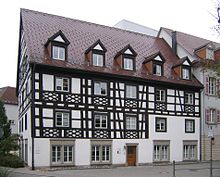
- The castle Donaueschingen and the associated park are the main attractions of the city. The castle was built in 1723 as an elongated functional building. In 1893/96 it was redesigned in the neo-baroque style and given a dome. The associated stables were built by Theodor Dibold in 1850. Another building in the palace complex is the court library and archive , which was built as a government building between 1732 and 1735 . The Princely Fürstenberg Collections are now housed in the Karlsbau, which was built in 1869.
- The “ Donauquelle ” with a group of figures by Adolf Heer is located in the castle park , which was laid out as a landscape garden from 1763 to 1819 . This shows the "mother Baar" her daughter, who shows the "young Danube" the way.
- The Belvedere on the "Schützenberg" in the Allmendshofen district, which was probably built between 1803 and 1827, was restored for EUR 128,000 and re-inaugurated on June 8, 2008. It was named " Monument of the Month August / September 2008" by the Monument Foundation Baden-Württemberg .
- The Catholic parish church of St. Johann Baptist was built from 1724 to 1747 in the Bohemian Baroque style. The two towers shape the cityscape of Donaueschingen and are the city's landmarks .
- The Catholic Church of St. Mary was built in 1927/28. The Evangelical Christ Church dates from 1949, but the previous church was built in 1912.
- In most parts of the city there are old Catholic churches (see #Religions ).
- The Gründerzeit Academy (Villinger Strasse 33) is a listed residential property in Donaueschingen. The building was built in 1921/22 and has been home to the “Max Egon Hospital” from October 1923. In April 1974 the use changed and the hospital became the "State Academy for Teacher Training". Since the formerly independent State Academies for Teacher Training in Calw, Donaueschingen, Esslingen-Zell and Comburg near Schwäbisch Hall were merged into the " State Academy for Training and Personnel Development at Baden-Württemberg Schools " with effect from January 1, 2004 , the former Locations in Calw and Donaueschingen merged in the new Bad Wildbad location, which was officially inaugurated on February 22, 2008.
Donauhallen
The Donauhallen (until 1974 Stadthalle Donaueschingen ) are a trade fair, congress and event center in the city center. They include a total of three halls and three seminar rooms with a total area of over 3,000 square meters. On September 11th 2010 the Donauhallen were reopened. The architectural goal was to combine the two existing individual halls - Mozart Hall and Bartók Hall - with the new Stravinsky Hall, a foyer landscape and the new seminar area to form a hall ensemble.
Regular events
- The Swabian-Alemannic Carnival is run in Donaueschingen by the fool's guild "Frohsinn". The most important fool figures are "Hansel" and "Gretle".
- Concert series Donaueschinger Musiktage with contemporary music (every year on the third weekend in October)
- Horse show CHI Donaueschingen
- Donaueschinger Dragon Days (every two years at the beginning of May kite makers from all over Germany, France and Switzerland meet)
- Donaueschinger Greyhound Days. The special ambience of this dog show for greyhounds has made the Donaueschinger Greyhound Days an international event that is now known and loved beyond European borders.
- Fürstenberg Polo Cup. The public event has taken place annually since 2007 on the private grounds of the Fürstenberg house.
Economy and Infrastructure
Companies
A regional company of Aldi Süd is located in Donaueschingen .
In the Aasen district, at the transition from the A 864 to the B 27 , there is a 4.1 MW agrovoltaic test facility with bifacial solar cells that are perpendicular to the current pasture. 47 ° 59 ′ 42 " N , 8 ° 31 ′ 54" E
traffic
Donaueschingen is an important regional railway junction where a total of four railway lines meet. The station Donaueschingen is through station on the Black Forest Railway from Karlsruhe to Konstanz and start Höllentalbahn from Donaueschingen via Neustadt to Freiburg . These two lines of the railway are considered technically exceptional structures . Donaueschingen is also the starting point of the Bregtalbahn to Bräunlingen , which previously continued to Furtwangen . The city belongs to the area of the Verkehrsverbund Schwarzwald-Baar and is connected to the Ringzug system. Donaueschingen is an intercity stop and has, for example, individual, continuous connections to Dortmund and Hamburg .
The city is located on the A 864 , a feeder to the A 81 Stuttgart - Singen (Hohentwiel) . Furthermore, the federal highways 27 Stuttgart- Schaffhausen ( Switzerland ), 31 Freiburg im Breisgau - Lindau and 33 Offenburg - Konstanz intersect in the city .
Donaueschingen is on a holiday route . This is the cross-border Green Road / Route Verte, which begins in the Vosges in Contrexéville , crosses the Rhine near Breisach am Rhein and ends in the north route in Lindau and in the south route in Konstanz .
The Donaueschingen airfield has around 27,500 take-offs and landings per year, the target is 37,000.
An Airbus A319-100 from Deutsche Lufthansa with the registration D-AILW bears the name "Donaueschingen".
Donaueschingen begins Danube Bike Path , one of the tourist-known and longest cycle paths in Europe.
Courts and authorities
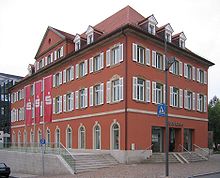
Donaueschingen is the seat of a local court belonging to the district court district of Konstanz , as well as a notary's office and also has branches of the tax office in Villingen-Schwenningen and the district office of the Schwarzwald-Baar district . In addition, Donaueschingen has an official seat of the regional council of Freiburg im Breisgau , which is responsible for federal motorways and federal highways in the Black Forest-Baar-Heuberg region.
The Staatliche Schulamt Donaueschingen is the school supervisory authority for all elementary, secondary, technical, secondary and community schools as well as special education and advice centers in the districts of Schwarzwald-Baar and Rottweil.
media
A local edition of Südkurier and a local edition of Schwarzwälder Bote report on local events in Donaueschingen as daily newspapers . The new Radio Neckarburg, as the responsible local broadcaster, also reports on the city, but the FM reception is not satisfactory everywhere in the city.
military
The Fürstenberg barracks in Donaueschingen is home to the Franco-German Brigade , which houses the German Jäger Battalion 292 and the 3rd Company of the Franco-German Supply Battalion . The French 110th Infantry Regiment was also stationed in Donaueschingen until it was disbanded. At the end of June 2014, the French soldiers left Donaueschingen after a parade.
Educational institutions
In Donaueschingen there is a general education grammar school ( Fürstenberg grammar school ), a secondary school (Realschule Donaueschingen), a special educational and advisory center with a focus on learning (Heinrich Feurstein school), a primary and technical secondary school (Eichendorff school), three primary schools ( Erich Kästner School with branches in Allmendshofen and Grüningen, Pfohren primary school with Aasen branch and Wolterdingen primary school).
The Schwarzwald-Baar district is the sponsor of the two vocational schools (commercial schools in Donaueschingen and commercial and home economics schools ( KHS Donaueschingen ), including a business high school) and a technical high school as well as the special education and advice center with a focus on intellectual development (Karl- Wacker School).
The adult education center in Baar, an association of the cities of Donaueschingen, Blumberg, Bräunlingen and Hüfingen, is a municipal further education institution and is based in Donaueschingen.
The evening secondary school, the Caritas Association's geriatric nursing school for the Archdiocese of Freiburg e. V. and the technical college for agriculture complete the educational offer in Donaueschingen.
Personalities
Honorary citizen
The city of Donaueschingen has granted the following people honorary citizenship:
- 1840: John Ruegger, Hofmeister
- 1896: Hermann Götz, director of the Grand Ducal School of Applied Arts
- 1908: Hermann Fischer, mayor
- 1913: Wilhelm Lukas Strauss, Privy Councilor
- 1918: Monsignor Carl Scheu, pastor
- 1923: Maximilian Egon II. Prince of Fürstenberg, Landgrave in the Baar and Stühlingen
- 1953: Georg Mall , alderman
- 1956: Max Egon Prince zu Fürstenberg
- 1973: Joachim Egon Fürst zu Fürstenberg
- 1974: Elisabeth Rothweiler , councilor (1956–1969), teacher and benefactor
- 2005: Bernhard Everke , Lord Mayor (until October 2004)
- 2008: Hans-Jürgen Bühler, City Councilor

sons and daughters of the town
- Anna Maria Schultheiss (1760–1840), ancestor of the Roman noble family Torlonia
- Joseph von Laßberg (1770–1855), forester, Germanist and writer
- Fidelis Scheu (1780–1830), physician, balneologist and specialist writer in Bohemia
- Mathias Aberle (1784–1847), Austrian physician
- Johann Nepomuk Zwerger (1796–1868), sculptor
- Ludwig Kirsner (1810–1876), pharmacist, member of the Reichstag and Landtag
- Joseph Weißhaar (1814–1870), landlord, politician, leader in the Baden Revolution
- Karl Egon III. zu Fürstenberg (1820–1892), Prussian officer, general of the cavalry, politician, member of the Prussian manor, large landowner
- Karl Roth von Schreckenstein (1823–1894), historian, writer and archivist
- Robert von Hornstein (1833–1890), composer
- Julius Diefenbach (1835–1917), engineer, councilor and member of the Reichstag
- Hugo Wehrle (1847–1919), violinist and royal Württemberg court conductor
- Hermann Götz (1848–1901), painter, lithographer, sculptor and craftsman and professor at the Karlsruhe School of Applied Arts
- Franz Ludwig Teufel (1848–1884), classical philologist, orientalist and librarian
- Wilhelm Vittali (1859–1920), architect
- Karl Kißling (1875–1953), medical director of the Mannheim hospitals
- Eugen Wannenmacher (1897–1974), dentist and university professor as well as SS-Sturmbannführer in the office of the Reichsarzt SS
- Karl Hahn (1901–1982), politician ( CDU ), Member of the Bundestag
- Max Güde (1902–1984), lawyer and politician
- Max Rieple (1902–1981), writer
- Hans Eisele (1913–1967), concentration camp doctor
- Cornelius Keller (1931–1994), chemist and university professor in Karlsruhe
- Helmut Maurer (1936–2018), historian and archivist
- Anselm Kiefer (* 1945), painter and sculptor
- Karin Rehbock-Zureich (* 1946), politician ( SPD )
- Christoph Haberer (* 1951), drummer and composer
- Werner Semmler (* 1952), publicist and publisher, creator of the Queen Auguste Victoria Park
- Lothar Wölfle (* 1958), politician (CDU), district administrator of the Lake Constance district
- Ali Güneş (* 1978), football player
- Christian Keller (* 1978), football official
- Simon Boch (* 1994), athlete
- Christoph Kessler (* 1995), athlete
People related to the city
- Wolfgang Amadeus Mozart (1756–1791), musician, stayed with his family for twelve days in the royal residence in 1766 and in 1786 almost became a royal court composer
- Heinrich Feurstein (1877–1942), Roman Catholic priest and art historian, was the parish priest of Donaueschingen
- Georg Tumbülle (1856–1947), archivist and historian, worked in Donaueschingen for over 60 years
- Klaus Bockisch (1938-2018), Bundesliga soccer player with Prussia Munster , died in Donaueschingen
- Hüseyin Avni Karslıoğlu (* 1956), Turkish diplomat and since January 2012 Turkish ambassador to Germany, spent part of his primary school days in Donaueschingen
- Dirk-Alexander Grams (* 1957), painter
- Gundolf Köhler (1959–1980), right-wing extremist and Oktoberfest bomber , grew up in Donaueschingen
- Marc Terenzi (* 1978), pop and rock singer, lived in Donaueschingen from December 2009 to April 2010
- Felix K. Maier (* 1981), ancient historian and classical philologist
annotation
- ↑ In Donaueschingen, Bertholdus pupillus is mentioned in 1292 , resident in Tůnovweschingen, […] Johannes de Tůnovweschingen : "The Donaueschingen Castle was an ancient ancestral seat of the Blumberg family." (Andre Bechthold: Blumberg. P. 39, quotation in note 80 in: Kindler von Knobloch: Upper Baden gender book . Vol. 1, p. 110.) The Blumberg rule existed there until 1450, when “Rudolf von der alten Blumberg d. J. zu Donaueschingen, [... who] died without leaving any male heirs. His brother-in-law, Ritter Sigmund vom Stein, was able to take possession of the property and fiefdoms without our being informed about the individual events. ”(Karl Bader: Herrschaft Blumberg. P. 19 f.)
literature
- Wilfried Ehbrecht: Donaueschingen (= German City Atlas. Lfg. 3, No. 2 = Acta Collegii Historiae Urbanae Societatis Historicorum Internationalis. Series C: Atlases ). GSV Städteatlas Verlag, Altenbeken 1984, ISBN 3-89115-002-4 .
- Erich Keyser (Ed.): German city book. Urban History Handbook. Baden town book. Volume 4: Southwest Germany. 2: State of Baden-Württemberg. Volume: Baden. Kohlhammer, Stuttgart 1959.
- Sigmund Riezler : History of Donaueschingen. In: Writings of the Association for History and Natural History of the Baar and the adjacent parts of the country in Donaueschingen. Issue 2, 1872, ZDB -ID 505223-3 , pp. 1–104 ( digital version (PDF; 15.32 MB) ).
- Volkhard Huth : Donaueschingen. City at the source of the Danube. A place in its historical development. Thorbecke, Sigmaringen 1989, ISBN 3-7995-4120-9 .
Web links
- Donaueschingen: Official homepage
- Historical sights in Donaueschingen
- Link list of the Baarverein to natural history and historical contributions to Donaueschingen and the suburbs
- Website of the Donauhallen
- Baden-Württemberg State Statistical Office: Demographic Profile Donaueschingen, City
Individual evidence
- ↑ State Statistical Office Baden-Württemberg - Population by nationality and gender on December 31, 2018 (CSV file) ( help on this ).
- ↑ https://www.leo-bw.de/media/kgl_atlas/current/delivered/pdf/HABW_7_11.pdf
- ↑ Christian Roder : The parish church in Grüningen and the old wall paintings recently discovered in the same . In: Journal for the history of the Upper Rhine (ZGO), vol. 45 (1891), pp. 636–644 ( digitized version ).
- ↑ a b c d e Federal Statistical Office (Hrsg.): Historical municipality register for the Federal Republic of Germany. Name, border and key number changes in municipalities, counties and administrative districts from May 27, 1970 to December 31, 1982 . W. Kohlhammer, Stuttgart / Mainz 1983, ISBN 3-17-003263-1 , p. 494 .
- ^ Federal Statistical Office (ed.): Historical municipality directory for the Federal Republic of Germany. Name, border and key number changes in municipalities, counties and administrative districts from May 27, 1970 to December 31, 1982 . W. Kohlhammer, Stuttgart / Mainz 1983, ISBN 3-17-003263-1 , p. 517 .
- ↑ State Gazette, August 8, 2008. P. 28
- ^ House Fürstenberg: Fürstenberg Polo Cup . Archived from the original on June 16, 2014. Info: The archive link was inserted automatically and has not yet been checked. Please check the original and archive link according to the instructions and then remove this notice. Retrieved June 11, 2014.
- ↑ Southwest: Franco-German Brigade: French withdraw soldiers - staff remains in Müllheim for the time being . In: Badische Zeitung , November 1, 2013, accessed December 8, 2013
- ^ Stephanie Jakober: Painful farewell to friends. In: Südkurier from June 24, 2014.
- ↑ Mozart Hall - ideal for congresses, wedding celebrations, banquets, galas, theater and concerts. (No longer available online.) Donauhallen.de, archived from the original on December 10, 2014 ; Retrieved December 5, 2014 . Info: The archive link was inserted automatically and has not yet been checked. Please check the original and archive link according to the instructions and then remove this notice.
- ↑ Marc Terenzi moves to Berlin - Off to Sarah! , N24, April 20, 2010, accessed November 23, 2012









